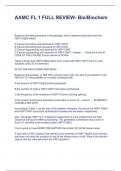Class notes
Biol 1000 - Photosynthesis notes
- Course
- Introductory Life Science
- Institution
- University Of The Witwatersrand (wits)
Photosynthesis may seem to be kind of complex and confusing, but guess what? This is a comprehensive and detailed note on photosynthesis,here to give you clear explanations,key concepts and illustrations on this topic. Essential!! To your success in Witwatersrand.
[Show more]





